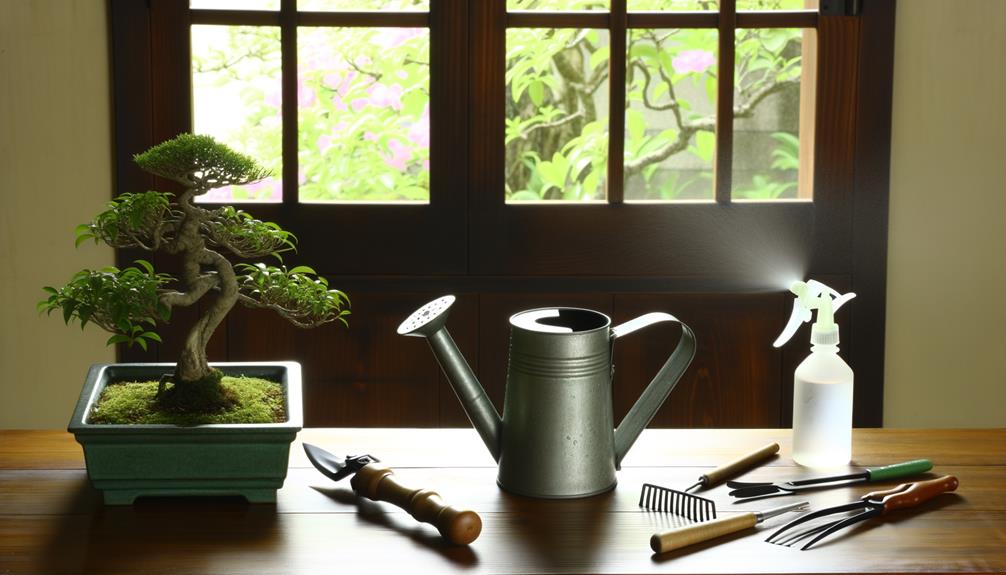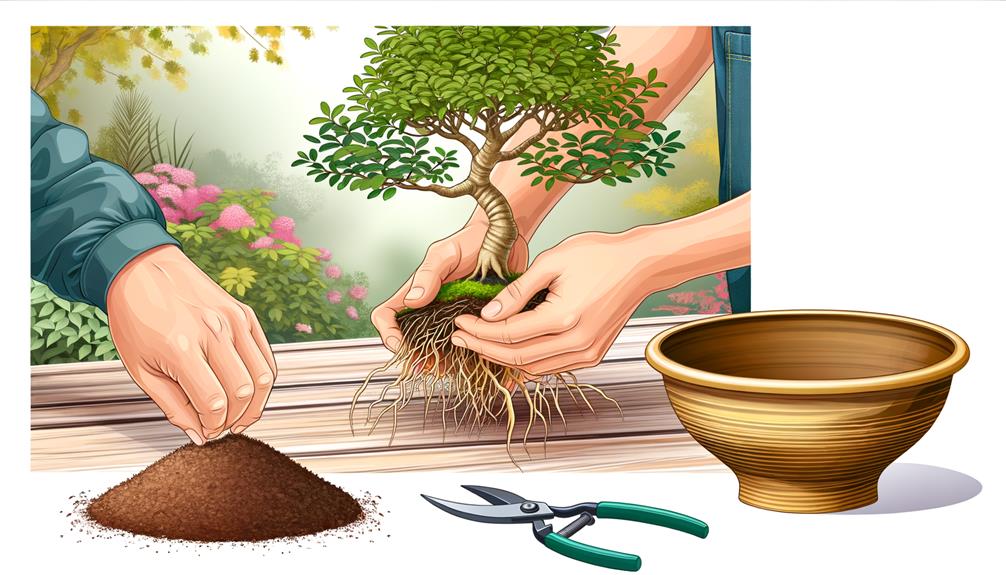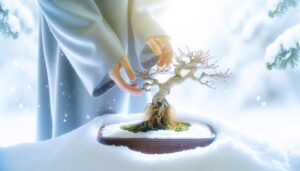Easy Ways to Take Care of Your Bonsai Plant
Proper care for a bonsai plant involves selecting a species that matches your climate, such as Ficus benjamina or Juniperus procumbens for beginners. Place it where it receives at least six hours of direct sunlight daily, rotating regularly for even exposure.
Maintain ideal temperature and humidity levels, keeping tropical species in 60-75°F environments. Water diligently, ensuring soil breathability to prevent root rot.
Prune using sterilized shears and wire to shape. Choose well-draining soil suitable for your bonsai's needs.
Monitor for pests and diseases, and adjust care seasonally. Avoid common mistakes like overwatering.
Explore detailed care techniques for a thriving bonsai.

Key Takeaways
- Ensure at least 6 hours of direct sunlight daily for optimal growth.
- Water the bonsai according to soil moisture levels to prevent root rot.
- Prune and shape regularly using sharp, sterilized shears for desired form.
- Use well-draining soil to maintain healthy root growth.
- Monitor and control pests proactively to prevent infestations.
Choosing the Right Bonsai

Selecting the appropriate bonsai species is vital for successful cultivation and should take into account factors such as climate adaptability, growth habits, and level of care required.
Species such as Ficus benjamina and Juniperus procumbens are often recommended for beginners due to their robust nature and reduced care demands.
Climate adaptability is essential; temperate species like Acer palmatum should be avoided in tropical regions where temperatures remain high.
Growth habits also play a significant role; slow-growing species like Pinus thunbergii can be challenging for novices.
Evaluate the level of care required, as some species necessitate frequent pruning, wiring, and repotting.
A thorough understanding of the selected species' botanical characteristics ensures optimal health and aesthetic appeal in bonsai cultivation.
Ideal Placement
Correct positioning of a bonsai is vital to its health and vigor. This requires careful consideration of sunlight needs, temperature, and humidity. Best light exposure guarantees photosynthesis, while keeping the delicate equilibrium of temperature and humidity safeguards against stress.
Furthermore, sufficient air movement prevents fungal infections and promotes strong growth.
Sunlight Requirements
Best sunlight exposure is crucial for bonsai health, necessitating placement in a location that receives at least six hours of direct sunlight daily. This level of light guarantees optimal photosynthesis, promoting robust growth and vibrant foliage. Positioning your bonsai on a south-facing windowsill or an outdoor space with ample morning sunlight can be advantageous.
| Light Condition | Ideal Placement |
|---|---|
| Full Sun | South-facing window or outdoor patio |
| Partial Shade | East or west-facing window, shaded outdoor area |
| Indirect Light | Bright indoor room with filtered light |
| Low Light | Not recommended for most bonsai species |
Ensuring the correct sunlight exposure prevents etiolation and maintains the compact structure characteristic of bonsai. Regularly rotate the plant to guarantee even light distribution.
Temperature and Humidity
Ensuring ideal temperature and humidity levels is crucial for the thriving growth of bonsai, as these environmental conditions closely mimic the plant's natural habitat.
Best placement should consider the specific species' requirements. Generally, tropical and subtropical bonsai prefer temperatures between 60-75°F (15-24°C) and high humidity levels. Conversely, temperate bonsai thrive in cooler conditions, typically 50-70°F (10-21°C), with moderate humidity.
To maintain humidity:
- Humidity Trays: Place bonsai on trays filled with water and pebbles to increase humidity levels.
- Misting: Regularly mist bonsai leaves with water to replicate natural moisture conditions.
- Humidifiers: Use room humidifiers to maintain consistent humidity, especially during dry seasons.
Adhering to these guidelines ensures robust bonsai health and strength.
Air Circulation
Sufficient air circulation is vital for bonsai health. It prevents fungal infections and promotes strong growth by guaranteeing a steady exchange of gases.
To achieve the best air flow, place your bonsai in a location that allows for gentle breezes. Protect it from strong winds that can dry out foliage.
Indoor bonsai benefit from positioning near a window that can be periodically opened. Using a small fan can also help maintain air movement.
Make sure that the chosen spot does not subject the bonsai to stagnant air. Stagnant air can harbor mold and pests.
Avoid placing the bonsai in overly crowded or confined spaces. This can impede air flow and compromise the plant's overall well-being.
Watering Techniques

Watering techniques are essential to the health of a bonsai tree. This requires precise attention to ideal watering frequency, proper methods, and identifying signs of overwatering. Consistency in moisture levels is crucial, achieved through specific watering practices tailored to the species and environmental conditions.
Recognizing symptoms of overwatering, such as root rot and yellowing leaves, is vital to maintaining a thriving bonsai.
Optimal Watering Frequency
Determining the ideal watering frequency for bonsai trees requires a thorough understanding of species-specific water needs, soil composition, and environmental conditions. Each bonsai species has distinct hydration requirements, influenced by its native habitat.
Soil composition, whether it is akadama, pumice, or lava rock, influences water retention and drainage. Environmental factors such as humidity, temperature, and light exposure also play an important role.
To evoke an emotional connection with your bonsai, consider the following:
- Observe daily: Checking soil moisture levels daily ensures timely adjustments.
- Seasonal adjustments: Alter watering frequency with seasonal changes to mimic natural growth cycles.
- Soil aeration: Guarantee soil breathability to prevent root rot and promote healthy growth.
Precision in watering frequency fosters vibrant, thriving bonsais.
Proper Watering Methods
Understanding the best frequency of watering sets the stage for employing effective watering techniques that guarantee thorough hydration without excessive saturation. Begin by using a moisture meter to accurately assess soil conditions.
When watering, employ the submersion method: immerse the bonsai pot in water until bubbles cease to rise, guaranteeing even soil saturation. Alternatively, apply water slowly using a fine-nozzle watering can, allowing water to permeate deeply without washing away topsoil.
Opt for rainwater or distilled water to avoid mineral buildup, which can impair root function. Monitor drainage to prevent waterlogging; ensure the pot has proper drainage holes, and utilize a well-draining soil mix.
These methods collectively ensure peak hydration while preserving root health and vigor.
Identifying Overwatering Signs
Recognizing the indicators of overwatering is crucial for maintaining the delicate balance necessary for bonsai plant health. Overwatering can lead to root rot, fungal infections, and eventual plant decline. Key signs include:
- Yellowing Leaves: Excessive moisture disrupts nutrient absorption, leading to chlorosis.
- Mushy or Blackened Roots: Waterlogged soil promotes root decay, which can be fatal if not addressed.
- Wilting Despite Moist Soil: Paradoxically, overwatered plants may wilt as roots suffocate from lack of oxygen.
To mitigate these issues, ensure proper drainage by using a well-draining substrate and pots with adequate holes. Regularly check soil moisture with a moisture meter or by touch, and adjust watering frequency based on seasonal changes and plant species needs.
Pruning and Shaping
Pruning and shaping are essential techniques in bonsai cultivation that involve the strategic removal of branches and foliage to maintain the desired aesthetic form and secure the health of the plant. Pruning encourages growth in specific areas, ensuring balanced distribution of resources.
Utilize sharp, sterilized shears to make clean cuts, removing any crossing or congested branches to enhance airflow and light penetration. Wiring is often used to guide branches into desired positions; wrap the wire around the branch and adjust gradually.
Seasonal timing is critical; prune deciduous species during dormancy and evergreens during active growth. Regular shaping and careful observation promote a harmonious structure, reflecting both artistic vision and botanical principles.
Soil Selection

Choosing the right soil for bonsai plants is essential for their health and growth. An ideal soil mix should balance organic and inorganic components to guarantee proper drainage, aeration, and nutrient retention.
Understanding the perfect soil composition and its role in preserving root health will greatly improve the longevity and vigor of your bonsai.
Ideal Soil Composition
To ensure prime growth and health of a bonsai plant, it is crucial to choose a soil composition that offers exceptional drainage, aeration, and nutrient retention.
The ideal bonsai soil mix typically includes:
- Akadama: A hard-baked Japanese clay that provides outstanding water retention and aeration properties, ensuring roots receive sufficient oxygen.
- Pumice: A volcanic byproduct that enhances drainage and helps maintain soil structure, preventing compaction over time.
- Lava Rock: Known for its durability and porosity, it aids in drainage while retaining enough moisture and nutrients for the plant's needs.
These components should be carefully blended to create a balanced medium that supports robust root development and overall well-being, tailored to the specific species of bonsai being cultivated.
Drainage and Aeration
A vital component in bonsai soil selection is guaranteeing best drainage and aeration, which are necessary for preventing root rot and promoting healthy root growth. Optimal drainage can be achieved by incorporating inorganic materials such as akadama, pumice, and lava rock. These substrates facilitate water flow and oxygen exchange, essential for root respiration.
A balanced mix typically consists of 30-40% organic matter, such as pine bark or compost, to retain moisture and nutrients. The remaining 60-70% should be inorganic to maintain structural integrity and prevent compaction. Regularly monitor soil moisture and avoid using garden soil, which is often too dense and retains excessive water.
Employing a well-draining, aerated soil mix will guarantee your bonsai thrives.
Fertilizing Tips
Understanding the specific nutrient requirements of your bonsai species is essential for developing an effective fertilizing regimen. Each bonsai type demands a tailored approach to nutrient supplementation.
Here are three critical considerations that can evoke a sense of mastery in bonsai care:
- Nutrient Balance: Maintain a balanced ratio of Nitrogen (N), Phosphorus (P), and Potassium (K). Utilize a 10-10-10 or 20-20-20 fertilizer.
- Seasonal Adjustments: Adjust fertilizing frequency and composition according to the growth cycle. Increase nitrogen during spring for vigorous growth, reduce it during dormancy.
- Organic vs. Inorganic: Choose between organic fertilizers, which release nutrients slowly and improve soil structure, or inorganic fertilizers for instant nutrient availability.
Following these guidelines guarantees robust bonsai health and aesthetics.
Repotting Guide

Repotting is a fundamental practice in bonsai care that maintains continued root health and ideal growth conditions. To achieve best results, follow these detailed steps. First, select the appropriate time, typically in early spring. Carefully remove the bonsai from its current pot and trim one-third of the root mass to stimulate new growth. Next, prepare a balanced soil mixture suitable for the species. Position the bonsai in a slightly larger pot, ensuring proper drainage. Secure the tree with wire and fill in with fresh soil.
| Step | Description | Importance |
|---|---|---|
| 1. Timing | Choose early spring | Minimizes stress and best recovery |
| 2. Root Trimming | Trim one-third of the root mass | Stimulates new growth and prevents root bound |
| 3. Soil Mix | Prepare species-appropriate soil | Provides necessary nutrients and aeration |
| 4. Positioning | Place in slightly larger pot with proper drainage | Prevents waterlogging and promotes health |
This meticulous process promotes strong development and aesthetic appeal.
Pest Control
Effective pest management is essential for maintaining the health and vitality of your bonsai, requiring vigilant monitoring and the application of targeted treatments to manage common infestations. Regularly inspect foliage, branches, and soil for signs of pests such as aphids, spider mites, and scale insects. Implementing integrated pest management (IPM) strategies can effectively control these pests.
- Physical Removal: Gently wash off pests with a fine spray of water or use a soft brush for delicate leaves.
- Biological Control: Introduce natural predators like ladybugs or predatory mites to keep pest populations in check.
- Chemical Treatments: Apply horticultural oils or insecticidal soaps, following manufacturer guidelines to avoid phytotoxicity and maintain plant safety.
Proactive pest management ensures a thriving bonsai.
Disease Prevention

To prevent diseases in bonsai plants, it is essential to maintain ideal environmental conditions, such as proper air circulation, humidity control, and appropriate watering practices. Ensuring adequate ventilation minimizes fungal growth and bacterial infections.
Regulate humidity levels to prevent conditions conducive to mildew and mold. Watering should be consistent but avoid waterlogging, which can lead to root rot. Employ well-draining soil and suitable containers to facilitate moisture control.
Regularly inspect foliage and roots for early signs of disease, such as discoloration, wilting, or unusual spots. Sterilize pruning tools to prevent the transmission of pathogens. Utilize fungicides and bactericides as preventive measures, adhering to recommended dosages.
Seasonal Care
During the spring season, bonsai plants benefit from increased daylight and warmer temperatures, which stimulate new growth and require adjustments in watering and fertilization routines.
To maintain the essential health and vigor, adhere to the following seasonal care guidelines:
- Watering: Increase the frequency of watering as the soil dries out more quickly due to higher temperatures. Ensure thorough saturation to reach deeper roots.
- Fertilization: Apply a balanced, slow-release fertilizer every two weeks to support vigorous growth. Monitor the nitrogen levels to avoid excessive foliage at the expense of root development.
- Pruning: Conduct structural pruning to shape the bonsai and remove any dead or weak branches. Focus on directing energy towards the desired growth areas, promoting a balanced and aesthetically pleasing form.
These practices will help maintain the vitality of your bonsai throughout the spring season.
Common Mistakes

Many enthusiasts inadvertently compromise the health of their bonsai by overwatering, which can lead to root rot and other detrimental conditions. Ensuring proper drainage and monitoring soil moisture levels are essential for maintaining root health.
Another prevalent error is insufficient light exposure; bonsai trees require specific photoperiods to thrive, and inadequate lighting can stunt growth and weaken the plant.
Additionally, improper pruning techniques can damage the bonsai's structure; precise cuts should be made with sterilized tools to prevent disease.
Fertilization mistakes, such as using incorrect formulations or frequencies, can also impair growth.
Lastly, neglecting to repot at appropriate intervals can result in root-bound conditions, further compromising the bonsai's well-being. Attention to these details fosters optimal plant health.
Conclusion
To sum up, the meticulous art of bonsai care includes intricate requirements for placement, watering, pruning, soil selection, pest control, disease prevention, and seasonal adjustments. This serves as an exquisite tribute to humanity's insatiable desire to impose order upon nature.
One might jest that such devotion to miniature horticulture is the pinnacle of human achievement. What better symbolizes mankind's triumph over the wild than a tree stunted to perfection, meticulously pruned into perpetual adolescence?






